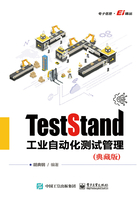
Preface
When we released TestStand 1.0 in December 1998,our ambitious goal was to bring the benefits of a quality modular software foundation with an open extensible architecture and highly functional components to the developers of test system software.Too often,we had witnessed National Instruments customers struggle with home grown or narrowly developed integrator supplied monolithic test executives that suffered from a lack of ongoing investment,scaled poorly,or were constrained by technology and quality issues.Our key challenge in providing an industry wide platform for test system development was that no two companies are alike in their requirements and priorities.Fortunately,National Instrument's unusually large and diverse base of test and measurement customers gave us a uniquely broad-based resource to draw upon for input and feedback in the design and architecture of TestStand.We had little choice but to make every aspect of TestStand flexible,configurable,and pluggable,to a degree that seemed outrageous at the time and sometimes still does.From user interfaces,process integration,file formats,parallelism,result storage,reporting,test configuration,all the way to the choice of programming language and development environment,TestStand provides flexibility,extension mechanisms,and even component source code,to ensure that test system developers can achieve the system they desire while leveraging a highly functional and coherent set of widely used well tested building blocks.
However,because of the numerous ways that TestStand can be utilized and customized,it is not always easy for developers new to TestStand to know what customizations or configurations to make in order to achieve their desired system.Fortunately,this is where Diangang's (Dylan) book excels.Drawing upon a wealth of real world project experience with a variety of customers,Dylan is able to present the concepts and mechanisms that TestStand provides while grounding the knowledge with concrete applications and examples.In addition to the depth and breadth of TestStand topics that Dylan's book covers,he also has the indisputable achievement of having created the world's finest TestStand resource in the Chinese Language.I appreciate Dylan's hard work,initiative,and the enthusiasm that he applied in creating this book and I'm looking forward to it helping an even wider audience of developers to benefit from building their systems with TestStand.
James Grey
NI公司研发部首席工程师,TestStand之父